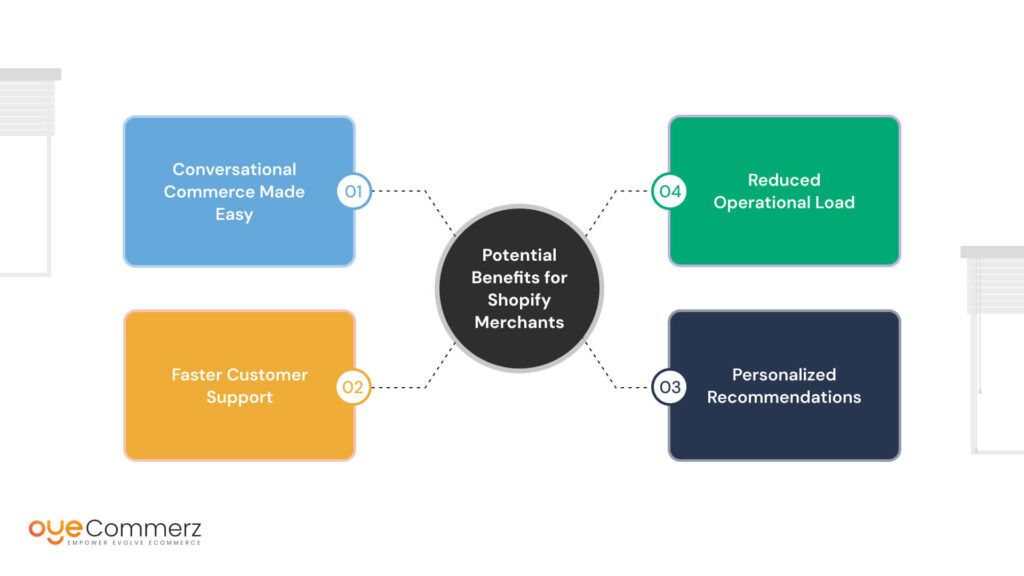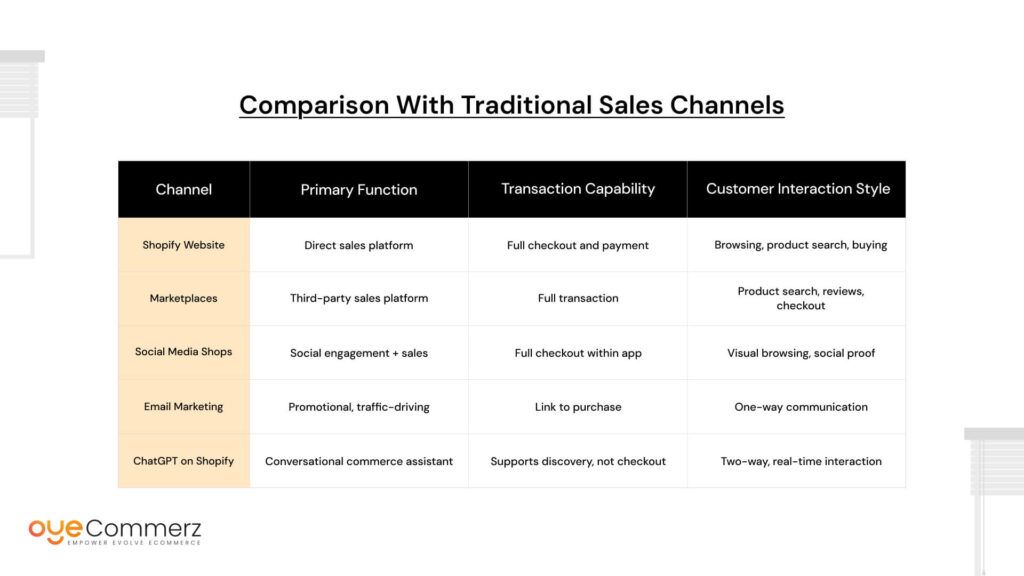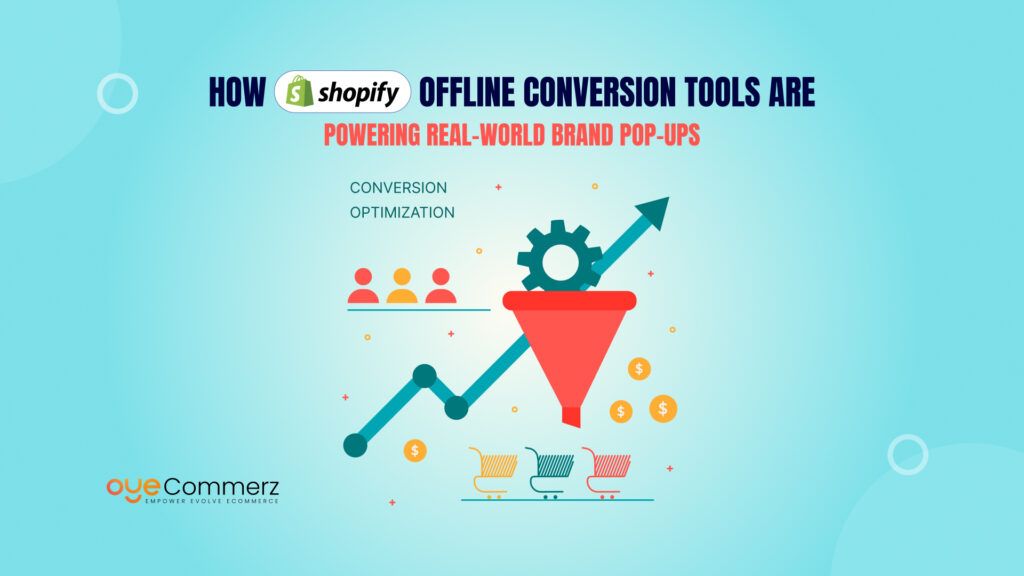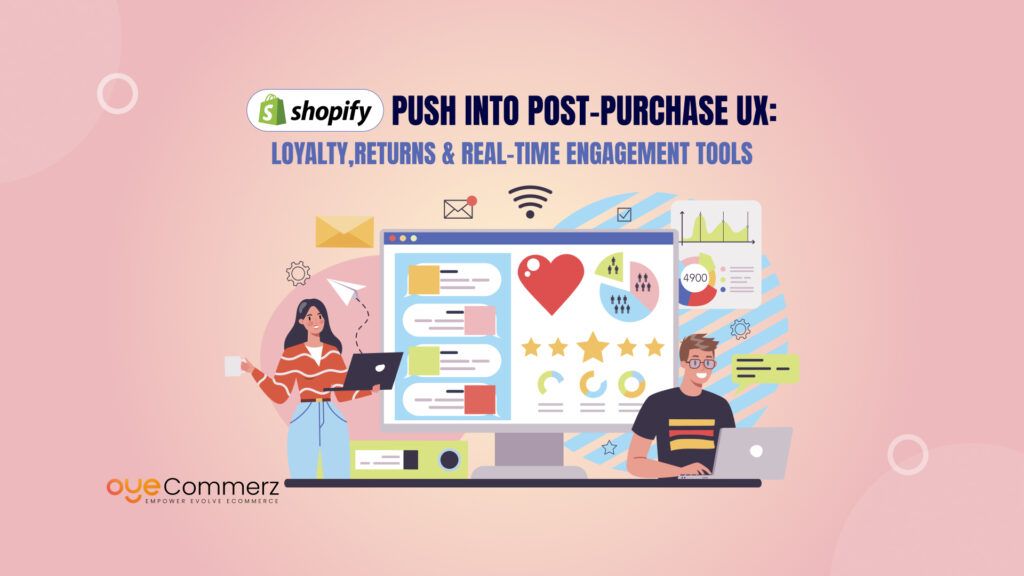Over 70% of online shoppers say they’re more likely to buy from brands that offer quick, conversational support.
That’s exactly what Shopify’s new integration with ChatGPT aims to deliver real-time, AI-driven assistance directly on your storefront. From answering product questions to guiding purchases, this integration is being hailed as the next big thing in eCommerce.
But is it truly a genuine sales channel or just another tech trend fighting for your attention?
Let’s find out.
What Is ChatGPT’s Shopify Integration?
Shopify’s integration with ChatGPT brings conversational AI directly into the heart of eCommerce. It allows merchants to embed ChatGPT into their Shopify storefronts, enabling intelligent, real-time interactions with customers across the buying journey.
At its core, this integration turns ChatGPT into a virtual assistant for your online store capable of handling product discovery, answering customer questions, providing tailored recommendations, and even assisting with the checkout process.
Key Features Include:
- AI-Powered Chat: Engage visitors in natural conversations that feel personal and responsive.
- Smart Product Discovery: Help shoppers find the right products faster based on needs, preferences, or questions.
- Automated Customer Support: Instantly resolve common queries, such as shipping info, order status, or return policies.
- Purchase Assistance: Guide users through product comparisons and checkout decisions to reduce friction.
Compatibility:
The integration works seamlessly with most Shopify themes and apps, including those for inventory management, CRM, and analytics ensuring a smooth experience for both merchants and customers.
This new capability positions ChatGPT not just as a chatbot, but as a potentially vital extension of your sales and support team.
Potential Benefits for Shopify Merchants

Integrating ChatGPT into your Shopify store doesn’t just mean adding a chatbot it means adding a smart, AI-powered assistant that can enhance customer engagement, improve conversions, and streamline operations. Let’s explore how this can transform the merchant experience.
2.1 Conversational Commerce Made Easy
Traditional online shopping can feel impersonal, often leaving customers to navigate product catalogs on their own. ChatGPT changes this by introducing real-time, human-like conversations to your storefront. Acting as a virtual shopping assistant, it can:
- Greet visitors when they land on your site.
- Ask clarifying questions to understand what the shopper is looking for.
- Suggest relevant products or categories based on their input.
- Guide them to the right page or offer product comparisons.
For example, if a customer types “I need a comfortable running shoe for long distances,” ChatGPT can respond with a list of bestsellers from that category, explain the features, and even mention size and color availability all within seconds.
This level of interactivity turns a static shopping experience into a dynamic, guided journey helping customers feel supported and reducing friction that often leads to cart abandonment.
2.2 Faster Customer Support
Customer service is a crucial part of any eCommerce operation, but responding to every question manually especially during peak times can stretch your team thin. ChatGPT helps by:
- Instantly answering frequent customer questions (e.g., “Where is my order?”, “What’s your return policy?”, “Do you ship internationally?”).
- Providing step-by-step guidance for returns, refunds, or exchanges.
- Escalating more complex issues to human agents when necessary.
This not only enhances customer satisfaction through instant support but also ensures your team spends less time on repetitive tasks and more on solving high-priority problems.
2.3 Personalized Recommendations
One of the most valuable aspects of ChatGPT is its ability to personalize the shopping experience in real time. By analyzing customer input and behavior, it can:
- Suggest products based on the customer’s needs or preferences.
- Recommend complementary items to increase upsell and cross-sell opportunities.
- Adjust suggestions based on browsing or purchase history.
For example, if a customer recently bought a yoga mat, ChatGPT might suggest yoga blocks, straps, or online classes. This kind of personalization not only improves the customer experience but also boosts average order value (AOV) and overall revenue.
2.4 Reduced Operational Load
Many daily tasks in eCommerce are repetitive and time-consuming. ChatGPT can take over several of these, such as:
- Answering FAQs about shipping, returns, sizing, and payments.
- Assisting with order tracking by integrating with Shopify’s back-end data.
- Providing updates on product availability and promotions.
- Offering pre-sales support without involving a human agent.
By automating these interactions, merchants can significantly reduce the workload on customer support and sales teams. This leads to improved operational efficiency and allows your staff to focus on strategy, growth, and higher-value customer interactions.
Is This a New Sales Channel?
To determine whether ChatGPT’s integration with Shopify qualifies as a new sales channel, it’s important to first understand what defines a sales channel.
What Is a Sales Channel?
A sales channel is any platform or method through which a business sells its products or services directly to customers. Common examples include:
- Online Storefronts: Your Shopify website where customers browse and buy.
- Marketplaces: Amazon, eBay, Etsy, etc., where sellers list products.
- Social Media Shops: Instagram Shopping, Facebook Shops, where users can buy directly within social apps.
- Email Marketing: Promotional emails with links to buy.
- Physical Stores: Brick-and-mortar locations.
A sales channel typically allows direct purchasing and involves a customer journey that leads to a transaction.
ChatGPT: Active Commerce Tool or Support Tool?
ChatGPT’s role on Shopify blurs the line between a sales tool and customer support assistant. While it primarily functions as a conversational interface to assist shoppers by answering questions and guiding product discovery, it can also:
- Suggest specific products based on customer needs.
- Help customers add products to their carts.
- Provide information to ease purchasing decisions.
However, ChatGPT usually doesn’t replace the actual checkout or payment process, which still happens on Shopify’s platform. Instead, it supports and nudges customers toward completing their purchase.
So, is it a sales channel? It depends on perspective:
- Yes, if you view it as a guided sales assistant that actively drives product discovery and influences buying decisions.
- No, if you consider only platforms that process transactions directly as true sales channels.
Comparison with Traditional Sales Channels

While ChatGPT doesn’t fully replace existing channels, it adds a conversational layer that enhances customer experience and may lead to higher conversion rates.
The Risks and Challenges
While ChatGPT’s integration with Shopify offers exciting possibilities, it also comes with potential risks and challenges that merchants should consider before fully embracing the technology.
4.1 Misalignment with Brand Voice
One of the biggest concerns when using AI like ChatGPT is maintaining a consistent brand voice. Since ChatGPT generates responses based on patterns in data rather than brand-specific guidelines, it can sometimes produce answers that:
- Feel generic or impersonal, which may weaken brand identity.
- Use language or tone that doesn’t align with your brand personality (too formal, too casual, or off-brand humor).
- Provide inaccurate or unclear responses that confuse customers.
This misalignment can affect how customers perceive your brand, making them question your professionalism or trustworthiness. To mitigate this, brands must customize and train the AI carefully, continually monitoring interactions for tone and content quality.
4.2 False Expectations from AI
While ChatGPT is powerful, it is not perfect and has limitations:
- It may struggle with complex or sensitive customer issues that require human judgment or empathy.
- The AI might misunderstand nuanced questions or context, leading to irrelevant or incorrect answers.
- Over Reliance on AI can create unrealistic expectations among merchants who assume it will replace all customer support needs.
It’s essential for merchants to set clear boundaries for the AI’s role using it primarily for FAQs, simple queries, and product guidance, while reserving complex cases for human agents.
4.3 Integration Complexity
Implementing ChatGPT effectively on a Shopify store is not always plug-and-play. Some challenges include:
- Technical setup: Connecting ChatGPT with your store’s backend, product database, and inventory systems may require custom development or third-party tools.
- User Experience (UX) design: Ensuring the AI chat interface is intuitive and unobtrusive on your site, without interrupting the shopping flow.
- Ongoing maintenance: Regular updates and monitoring to improve responses, fix bugs, and align with evolving products and policies.
- Data privacy and security: Safeguarding customer data used during AI interactions to comply with regulations and maintain trust.
Without careful planning, the integration could lead to customer frustration, lost sales, or brand damage.
Is It a Distraction?
The rapid rise of AI tools like ChatGPT inevitably triggers excitement and sometimes hype within the eCommerce community. But it’s important to step back and ask: is jumping on this trend a smart move, or could it become a distraction?
The Hype Cycle of New Technology
New technologies often go through a hype cycle: initial enthusiasm leads to inflated expectations, followed by a period of disillusionment before real, practical use cases emerge. ChatGPT’s integration with Shopify is still early in this cycle.
While it offers innovative capabilities, merchants risk overestimating its immediate impact. Chasing every new “shiny” AI feature can divert time and resources from proven growth strategies like improving product quality, marketing, and customer experience.
Risks of Focusing Too Much on Tools vs. Strategy
A common pitfall is to treat tools like ChatGPT as a silver bullet for sales growth. Without a clear strategy, adding new technology can:
- Scatter focus across multiple platforms or features without driving meaningful results.
- Create complexity and technical debt without improving customer satisfaction.
- Lead to poor implementation that harms brand reputation.
True growth comes from aligning technology with your overall business goals, not adopting tools simply because they’re trendy.
When to Adopt and When to Wait
Consider adopting ChatGPT integration if:
- Your store receives frequent repetitive questions that could be automated.
- You want to enhance real-time engagement and product discovery.
- You have resources to customize and maintain the AI for brand consistency.
- You are ready to test new channels as part of a broader customer experience strategy.
Consider waiting if:
- You are still struggling with basic eCommerce fundamentals like product-market fit or fulfillment.
- Your team lacks technical capacity to properly implement and monitor AI tools.
- You haven’t yet optimized core sales channels or marketing efforts.
- You want to observe how early adopters perform before investing.
How to Decide if It’s Right for Your Store

Deciding whether to adopt ChatGPT’s integration on your Shopify store requires thoughtful evaluation. Here’s a simple checklist to help you determine if this AI-powered tool is a good fit for your business:
1. Size of Your Catalog
- Large or diverse product range: If you offer hundreds or thousands of SKUs, ChatGPT can help customers navigate your inventory by quickly guiding them to relevant products.
- Small catalog: If you only have a few products, the value of AI-powered discovery may be limited, and simpler navigation options might suffice.
2. Volume of Customer Queries
- High query volume: Stores receiving frequent questions about products, shipping, returns, or sizing can greatly benefit from automating responses to reduce support load.
- Low query volume: If customer inquiries are minimal, the cost and effort of implementing ChatGPT may not justify the benefits.
3. Team Capacity
- Dedicated support or tech team: If you have staff to customize, monitor, and maintain the AI integration, you can ensure it aligns with your brand voice and performs well.
- Small or busy teams: Without resources to manage the AI, poor responses or technical issues might negatively impact customer experience.
4. Tech Budget
- Adequate budget: Consider costs for setup, customization, and ongoing maintenance. Investing in AI tools without proper funding can lead to underperformance.
Limited budget: Prioritize essential tools and foundational improvements before adding advanced AI features.
Final Verdict: Transformative Innovation or Temporary Trend?
As we wrap up, it’s important to weigh the strengths and limitations of ChatGPT’s Shopify integration to understand its true potential in eCommerce.
Summary of Pros and Cons
Pros:
- Enhances customer engagement with personalized, conversational shopping assistance.
- Speeds up customer support by automating common queries.
- Offers tailored product recommendations that can boost sales and average order value.
- Reduces operational workload, freeing your team to focus on complex tasks.
Cons:
- Risks misalignment with your unique brand voice if not carefully managed.
- Can’t fully replace human agents for complex or sensitive customer issues.
- Integration may involve technical challenges and ongoing maintenance.
- Potential for distraction if adopted without a clear strategic plan.
The Future Outlook
ChatGPT integration is more than just a fleeting tech trend; it represents a significant step toward more intelligent, conversational commerce experiences. As AI technology matures and merchants refine implementation, this tool is likely to become an integral part of the Shopify ecosystem, complementing existing sales and support channels.
However, success depends on thoughtful adoption, continuous optimization, and aligning the AI’s capabilities with your business goals. Those who leverage it strategically stand to gain a competitive advantage through improved customer experiences and operational efficiency.
Need Help Integrating AI Into Your Shopify Store?
Implementing ChatGPT and other AI tools effectively requires expertise to ensure they align with your brand and deliver real value. If you’re looking to unlock the full potential of AI-powered commerce on Shopify, professional guidance can make all the difference.
At Oyecommerz, we specialize in helping Shopify brands seamlessly integrate AI solutions tailored to their unique needs. Our services include:
- Comprehensive AI readiness audits to identify opportunities and gaps in your current setup.
- Custom ChatGPT integration and configuration designed to match your brand voice and business goals.
- Ongoing AI training and optimization to keep your virtual assistant performing at its best.
Ready to elevate your Shopify store with cutting-edge AI? Contact Oyecommerz today to get started with a personalized consultation and take your eCommerce experience to the next level.
Contact to Migrate your Site to Shopify Now
Conclusion
ChatGPT’s integration with Shopify offers exciting opportunities to enhance customer engagement and streamline operations. However, embracing new technology requires balancing innovation with focus. While AI can elevate your store’s performance, it should complement not distract from your core business strategies.
Merchants are encouraged to stay curious and open to emerging tools like ChatGPT, but always adopt them with clear goals and careful planning. By combining strategic thinking with thoughtful implementation, you can harness AI’s potential to create meaningful growth and lasting customer relationships.
Frequently Asked Questions
Yes, you can connect ChatGPT to Shopify through custom integrations or third-party apps that use OpenAI’s API. This allows you to add AI-powered chat features for customer support, product recommendations, and more on your Shopify store.
Shopify integrates with a wide range of tools and platforms including payment gateways (like PayPal, Stripe), marketing tools (Google Ads, Facebook), shipping providers, inventory management systems, CRM software, email marketing platforms, and AI chatbots, among others. These integrations help streamline store management and enhance customer experience.
To integrate a chatbot in Shopify, you can:
Use an existing chatbot app from the Shopify App Store (like Tidio, Drift, or Re:amaze).
Connect a custom chatbot via API, such as one powered by ChatGPT, by working with developers or AI service providers.
Install the chatbot app, configure it with your preferences, and embed it on your store’s website to start engaging with customers.
Shopify itself doesn’t offer a native AI chatbot built in, but it supports integration with many AI chatbot solutions through its app ecosystem. Additionally, recent developments have introduced partnerships and APIs (like with ChatGPT) that enable Shopify merchants to add AI-driven conversational tools to their stores.




